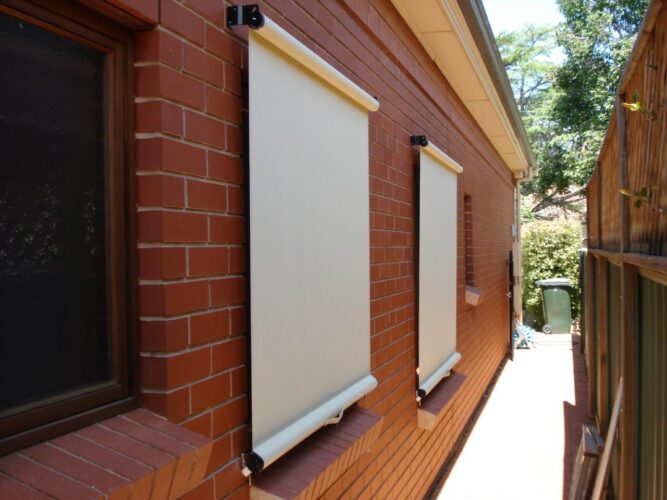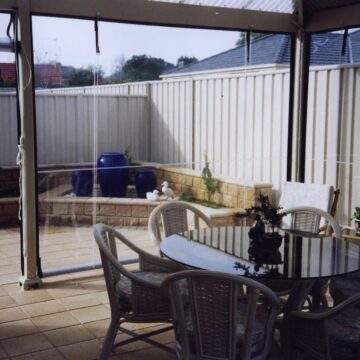Planning outdoor blinds and trying to pin down a budget can be maddening. One minute you’re seeing DIY patio blinds for pocket money, the next you’re quoted thousands for a motorised, track‑guided system. Add jargon like Ziptrak, Zipscreen, straight drop, wire‑guide and café PVC, plus extras such as pelmets, powder‑coating, wider spans and electrician costs, and it’s hard to compare apples with apples. Whether you’re shopping at Bunnings, ordering online, or considering a factory‑direct install, you need clear price brackets you can trust.
This 2025 Australia cost guide breaks down outdoor blinds prices by type and buying path—off‑the‑shelf DIY, online made‑to‑measure supply‑only, custom installed straight drop and track‑guided (manual and motorised), wire‑guide, café PVC and folding arm awnings—along with installation and electrical allowances. For each, you’ll get what it is, typical price ranges, pros and trade‑offs, plus buying and quote tips. We’ll also highlight a factory‑direct option in Adelaide and how to secure accurate local quotes. Ready to compare your options with confidence?
1. Classic Roller Shutters Adelaide: factory-direct outdoor blinds and local quotes
What it is
A locally manufactured, factory‑direct option in Adelaide offering custom outdoor blinds including track‑guided (Zip‑style), straight drop mesh and café PVC. You get in‑home advice, free measure and quotes, quotes from floor plans, plus installation, repairs and electrical upgrades handled by one team.
Typical 2025 price range (Australia)
Industry pricing guides indicate custom installed crank/straight‑drop blinds commonly land around $1,500–$2,500 per blind. Track‑guided manual systems are often $2,500–$4,000, while motorised versions typically range $2,500–$6,000 depending on size, pelmets, powder‑coating, fabric and electricals.
Pros and trade-offs
Factory‑direct keeps margins tight, improves lead times and accountability, and allows true made‑to‑measure with local after‑care. It won’t beat off‑the‑shelf DIY on headline price, and site works or access can add to the final number.
Buying and quote tips
Ask for itemised pricing on pelmets, powder‑coat, posts/flashings and electrician allowances to compare outdoor blinds prices like‑for‑like. Share widths/heights, wind exposure, mesh vs PVC preference and colour early, or provide plans for a faster, firm quote.
2. Off-the-shelf patio/bistro blinds (DIY)
What it is
Pre‑packed PVC or shade‑mesh “bistro” blinds from hardware stores. They’re sized in set widths/heights with simple rope/zip or crank operation and screw straight to pergola posts or fascias—great for a quick, budget DIY weather and privacy screen.
Typical 2025 price range (Australia)
Outdoor blinds prices at this end typically sit in the lower brackets: expect roughly $400–$1,000 per blind depending on size and material, with around 1200 x 1200 mm commonly $400–$600 and 3000 x 2400 mm from $1,000+ (product only).
Pros and trade-offs
These DIY kits keep costs down and are available immediately, but they’re not fully enclosed, so wind, rain and insects can still enter, and durability varies by fabric and fittings.
- Pros: Lowest upfront cost; fast DIY; easy replacement.
- Trade-offs: Limited spans/colours; less weather seal; clear PVC can mark/cloud over time.
Buying and quote tips
Start with accurate width/height and wind exposure. Check what hardware is included and whether you need extra posts/flashings for gaps. Compare mesh vs clear PVC for heat, glare and clarity, and confirm store return/warranty terms before you buy.
3. Online made-to-measure supply-only outdoor blinds
What it is
Custom-sized outdoor blinds ordered online and delivered to your door for DIY installation. Common options include shade-mesh straight drops and café‑style clear/tinted PVC, with selectable colours, hardware and pelmets to suit your opening.
Typical 2025 price range (Australia)
For supply‑only product, outdoor blinds prices typically run about $400–$1,000+ per blind depending on size, material and type. As a guide, around 1200 x 1200 mm lands roughly $400–$600, while 3000 x 2400 mm is often $1,000+. Some retailers advertise free delivery on orders over ~$499. Excludes installation.
Pros and trade-offs
You save on labour and get precise sizing and finish options, but accuracy rests on your measurements and install skill.
- Pros: Lower total cost than installed; custom fit; broad fabric/colour choices; quick online checkout.
- Trade-offs: DIY risk on measure/install; freight/lead-time variables; supply‑only warranties; limited site advice.
Buying and quote tips
Lock in specs before ordering and ask for itemised extras so you can compare like‑for‑like.
- Measure twice: Confirm finished width and drop, fixing face, and clearance.
- Specify materials: Compare mesh grades/openness (e.g., ~94% vs 99%) and PVC clarity.
- Itemise options: Pelmets, powder‑coating, bottom bars, side seals, brackets.
- Check logistics: Lead times, shipping insurance, returns for custom goods, and after‑sales support.
4. Straight drop crank outdoor blinds (custom installed)
What it is
Custom-made straight‑drop blinds using a hand‑crank gearbox to raise/lower a weighted bottom bar. They fix top and bottom with open sides (no side rails), typically in shade mesh or clear/tinted PVC for daytime privacy and glare control.
Typical 2025 price range (Australia)
Expect around $1,500–$2,500 per blind installed for crank‑style straight drops, varying by size, fabric choice (mesh vs PVC), colour/finish and site conditions, based on current Australian industry pricing guides.
Pros and trade-offs
A value choice when you want shade without the cost of tracks or motors.
- Pros: Lower cost than track‑guided; simple to operate; versatile for many pergolas.
- Trade-offs: Not fully enclosed—wind/rain/insects can enter; less stable in gusts; fewer sealing options than track‑guided systems.
Buying and quote tips
Ask for itemised inclusions so outdoor blinds prices are comparable across quotes.
- Measure accurately: finished width/drop, fixing face and wind exposure.
- Specify fabrics/finishes: higher block‑out meshes and custom powder‑coat add cost.
- Note site works: posts/flashings to close gaps, access or double‑storey install can lift price.
- Confirm aftercare: warranties on gearboxes, fabrics and hardware, and local service.
5. Track-guided blinds (Ziptrak/Zipscreen style), manual operation
What it is
Track‑guided blinds run in side channels that capture the fabric, keeping it stable through the movement and improving sealing compared with open‑sided drops. Manual units are typically spring‑assisted for easy lift/lower, with optional enclosed pelmets and side/seal options to help cut wind, rain and insects around patios and alfrescos.
Typical 2025 price range (Australia)
Typical installed outdoor blinds prices for manual track‑guided systems are around $2,500–$4,000 per blind, depending on size, fabric grade, pelmet/powder‑coat and site conditions. Many systems can span up to about 6 m, noting exposure and fixings may affect feasibility.
Pros and trade-offs
You’ll pay more than for crank straight drops, but you gain stability, usability and better weather control.
- Pros: Guided side tracks reduce blow‑in; smoother operation with spring assist; better sealing with pelmet/gaskets.
- Trade-offs: Higher price than basic crank; site prep (posts/flashings) may be needed; very wide spans may warrant motors.
Buying and quote tips
To compare like‑for‑like, lock down dimensions, materials and site works up front.
- Specify fabric: common meshes (~94% block) vs tighter weaves/PVC will change cost/performance.
- Add pelmets/seals: price them as separate line items.
- Note exposure: wind zones, balcony installs and access can lift install costs.
- Consider width: for regular use above ~4.5 m, ask if motorisation is recommended.
6. Motorised outdoor blinds (track-guided or straight drop)
Motorisation adds push‑button convenience to larger spans and high‑use areas, ideal for patios and alfrescos you open and close daily. It’s available on both track‑guided systems and straight‑drop styles in mesh or PVC.
What it is
A custom outdoor blind with an integrated electric motor controlled by remote or wall switch. Installation is handled by outdoor blind technicians with an electrician engaged at the same time for power and commissioning.
Typical 2025 price range (Australia)
Industry guides put installed motorised outdoor blinds at roughly $2,500–$6,000 per blind, scaling with width/height, fabric grade, pelmet, powder‑coat and site access. Track‑guided options commonly span up to around 6 m, subject to exposure and fixings.
Pros and trade-offs
You’re paying more than manual, but you gain ease of use and a neater finish—especially valuable on wider openings.
- Pros: One‑touch operation, better for large spans, clean look with enclosed pelmets.
- Trade-offs: Higher upfront cost, needs electrician, more components to service.
Buying and quote tips
To compare outdoor blinds prices like‑for‑like, lock down the specification and inclusions upfront.
- Itemise the motor/controls, handsets, pelmet and powder‑coat.
- Confirm electrical: is the electrician included or a separate allowance?
- Note width/use: above ~4.5 m, regular use often warrants automation.
- Account for site works: posts/flashings for gaps, wind exposure, access, and warranties on motor/fabric/hardware.
7. Wire-guide awnings for balconies and decks
Perfect for apartments and raised decks where side tracks aren’t practical, wire‑guide awnings keep the fabric true using slim stainless‑steel cables, preserving views and airflow while adding shade and daytime privacy.
What it is
A straight‑drop blind guided on tensioned stainless‑steel wires, operated by crank or motor, finished in shade mesh or PVC with optional pelmet.
Typical 2025 price range (Australia)
Installed prices typically align with crank straight‑drops: about $1,500–$2,500 per blind. Motorised versions generally sit around $2,500–$6,000, varying by size, fabric, pelmet/powder‑coat and access.
Pros and trade-offs
More minimalist than tracks, but with less sealing against weather.
- Pros: Slim hardware, good for balustrades, keeps views/airflow, height‑stoppable.
- Trade-offs: Not fully enclosed, movement in wind, needs solid fixings, coastal corrosion risks.
Buying and quote tips
Lock down fixings and finishes to compare outdoor blinds prices fairly.
- Fixings: top (soffit/wall) and bottom (floor/rail) details.
- Materials: 316 stainless cables; mesh openness (e.g., ~94% vs tighter weaves).
- Options: itemise pelmets, powder‑coat, brackets/flashings.
- Site factors: balcony access, wind exposure, high‑rise install and warranties.
8. Café blinds in clear or tinted PVC (custom)
What it is
Custom clear or tinted PVC panels, made to your opening and installed as straight‑drop or track‑guided blinds. Designed to preserve views while cutting wind and rain for patios, pergolas and alfrescos.
Typical 2025 price range (Australia)
Installed prices are commonly $1,500–$2,500 per blind for crank straight‑drops, or $2,500–$6,000 for track‑guided/motorised PVC, varying by size, pelmet, powder‑coat and access.
Pros and trade-offs
Great weather protection with visibility; consider these trade‑offs.
- Pros: Clear views; improved rain/wind barrier when sealed.
- Trade-offs: Heat build‑up; careful cleaning to keep clarity; not recommended down in strong winds.
Buying and quote tips
Get itemised quotes so you can compare outdoor blinds prices fairly.
- Specify: clear vs tinted PVC; track‑guided vs crank.
- Itemise: pelmets, powder‑coat, seals, posts/flashings.
- Confirm: exposure, spans, balcony/double‑storey access.
- Ask: care/cleaning requirements, warranties and lead times.
9. Folding arm awnings for patios and alfrescos
What it is
Retractable awnings that project from a wall or soffit using articulated arms, creating instant shade without posts or side tracks. They park neatly away when not in use, preserve head height and traffic flow, and suit entertaining areas where you want open space. Available as manual crank or motorised, in acrylic canvas or high‑performance mesh, with optional semi or full cassette hoods.
Typical 2025 price range (Australia)
Based on current Australian industry pricing guides, installed folding arm awnings broadly overlap other custom blind categories: manual crank units often sit around $1,500–$2,500 per unit, while motorised versions commonly land about $2,500–$6,000+, depending on width, projection, cassette type, fabric, powder‑coating and electricals.
Pros and trade-offs
You gain generous shade without posts, but these systems don’t enclose against wind or rain.
- Pros: Wide, post‑free coverage; retracts cleanly; great for entertaining; flexible projection/pitch.
- Trade-offs: No side/front seal; wind limits apply; motor/sensors add cost; requires solid fixings.
Buying and quote tips
To compare outdoor blinds prices like‑for‑like, lock down size and hardware early.
- Confirm span/projection: finished width, desired projection and mounting face (wall/soffit).
- Choose hooding: semi vs full cassette; itemise powder‑coat colours.
- Select fabric: acrylic vs mesh for heat/glare control and colourfastness.
- Wind/safety: ask about wind ratings, motion/sun sensors and tie‑down options if offered.
- Electricals: itemise motor, handsets/wall switch and electrician allowance.
- Fixings: balcony or masonry specifics, bracket locations and any needed steel or posts.
10. Installation, electrical and site-prep costs in 2025
What it is
Beyond the product price, your total outdoor blinds cost is shaped by install labour, electrician works for motorised systems, and site-prep such as posts, flashings to square openings, pelmets, and custom powder-coating. Access (balconies, double‑storey), wide spans and fabric upgrades also influence time on site and the final invoice.
Typical 2025 price range (Australia)
These factors are typically wrapped into installed pricing bands: crank/straight‑drop installs commonly sit around $1,500–$2,500 per blind, manual track‑guided about $2,500–$4,000, and motorised options roughly $2,500–$6,000. Variations reflect fabric grade, pelmet choice, custom coatings, structural adjustments and installation location, with electricians engaged alongside motorised installs.
Pros and trade-offs
Bundled versus itemised pricing both have merits; clarity is key either way. Expect firmer quotes once measurements, exposure and fixings are confirmed.
- Bundled convenience: One number, coordinated trades, simpler scheduling.
- Itemised clarity: Line items for pelmets, powder‑coat, posts/flashings and electrical.
- Trade-offs: Extras can emerge on complex sites; access and wind zones may add time.
Buying and quote tips
Aim for like‑for‑like quotes so outdoor blinds prices are genuinely comparable. Provide dimensions, exposure, photos or plans upfront for accuracy.
- Itemise: pelmets, powder‑coat, posts/flashings, seals, removal/disposal.
- Confirm electrical: whether the electrician is included for motors and controls.
- Note access: balconies, double‑storey, tight sites and lead times.
- Specify fabrics: mesh openness (e.g., ~94% vs tighter) or PVC clarity.
- Document width/use: frequent use over ~4.5 m may warrant motorisation.
Next steps
You’ve now got clear brackets: DIY supply can sit under $1,000 per blind; custom installed manual systems commonly land around $1,500–$4,000; motorised solutions are typically $2,500–$6,000. Track‑guided improves sealing and stability, straight‑drop is the value play, and PVC lifts weather protection but needs care.
To move from ballpark to firm pricing:
- Measure openings (width/drop), note wind exposure, and snap a few photos.
- Decide mesh vs PVC and whether you want pelmets/powder‑coat.
- Set a per‑opening budget and get 2–3 itemised quotes (including electrician if motorised).
- Confirm lead times, warranties and any posts/flashings.
In Adelaide and surrounds, book a free local quote with a factory‑direct team: Classic Roller Shutters Adelaide can measure, advise and install with one point of accountability.




